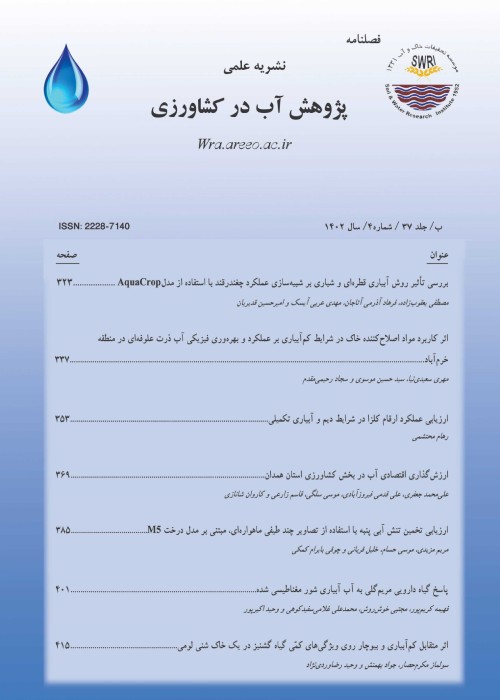Effect of Wick Irrigation System on Water Productivity, Growth and Yield Parameters of Tomato Plants in Greenhouse
This study aimed to evaluate the efficiency of wick irrigation system in greenhouse cultivation of tomato plant and compare it with drip irrigation. The experiment was performed as factorial with a completely randomized design (CRD) in the research greenhouse of Tarbiat Modares University in 2021. Irrigation treatments included five levels (drip irrigation and wick irrigation with diameters of 1, 3, 4, and 5 cm) and two soil combination ("cocopeat, soil, fertilizer, perlite" and "soil, sand, fertilizer"), in 3 replications. The lowest and highest water consumption during the growing season was observed in wick irrigation with a diameter of 1 cm (29.25 L/plant) and in drip irrigation and wicks with a diameter of 5 cm (36 and 37.5 L/plant), respectively. The results showed differences of 19% and 4% in water consumption between, respectively, wick irrigation with a diameter of 1 and 5 cm compared to drip irrigation. Also, the difference in water consumption between wick irrigation (minimum and maximum water consumption) of 1 and 5 cm diameters was 28%. The yield in "soil, sand, fertilizer" cultivation bed was increased by 59% compared to the "cocopeat, soil, fertilizer, perlite" cultivation bed and the maximum tomato yield (700gr/plant) was observed in the wick irrigation with a diameter of 3 cm. Water consumption index in "soil, sand, fertilizer" cultivation bed was decreased 21%, rather than "cocopeat, soil, fertilizer, perlite" cultivation bed and increased water productivity by 100%. In wick irrigation, since water is always available, the plant does not face water stress and these results indicate that the wick irrigation system improves plant growth and increases production of wet and dry matter and water productivity in tomato plant. Although economic analysis has not been done in this research, but more crop yield along with less water consumption in the wick irrigation system would have more income for the user and can be an acceptable reason for using this irrigation method.
- حق عضویت دریافتی صرف حمایت از نشریات عضو و نگهداری، تکمیل و توسعه مگیران میشود.
- پرداخت حق اشتراک و دانلود مقالات اجازه بازنشر آن در سایر رسانههای چاپی و دیجیتال را به کاربر نمیدهد.


